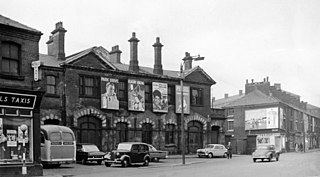The Bolton and Leigh Railway (B&LR) was the first public railway in Lancashire, it opened for goods on 1 August 1828 preceding the Liverpool and Manchester Railway (L&MR) by two years. Passengers were carried from 1831. The railway operated independently until 1845 when it became part of the Grand Junction Railway.

The motive power depot is the place where locomotives are usually housed, repaired and maintained when not being used. They were originally known as "running sheds", "engine sheds" or, for short, just sheds. Facilities are provided for refuelling and replenishing water, lubricating oil and grease and, for steam engines, disposal of the ash. There are often workshops for day to day repairs and maintenance, although locomotive building and major overhauls are usually carried out in the locomotive works.

Tain railway station is an unstaffed railway station serving the burgh of Tain in the Highland council area of Scotland. The station is on the Far North Line.

Barrow Hill railway station is a former railway station in the village of Barrow Hill in northern Derbyshire, England.

Bolton Great Moor Street railway station was the first station in Bolton. It was opened on 11 June 1831 by the Bolton and Leigh Railway.
Atherleigh railway station served an area of Leigh in what was then Lancashire, England. It was located on the Bolton and Leigh Railway line which ran from Kenyon Junction to Bolton Great Moor Street.
Atherton Bag Lane railway station served an area of Atherton, Greater Manchester in what was then Lancashire, England. It was located on the Bolton and Leigh Railway line which ran from Bolton Great Moor Street to Leigh Station and the Leeds and Liverpool Canal and later to Kenyon Junction.
Walkden Low Level railway station served the community of Walkden, Greater Manchester, England.
Little Hulton railway station served the village of Little Hulton, Greater Manchester, England.
The Tyldesley Loopline was part of the London and North Western Railway's Manchester and Wigan Railway line from Eccles to the junction west of Tyldesley station and its continuance south west via Bedford Leigh to Kenyon Junction on the Liverpool and Manchester Railway. The line opened on 1 September 1864 with stations at Worsley, Ellenbrook, Tyldesley, Leigh and Pennington before joining the Liverpool and Manchester Railway at Kenyon Junction.
Kenyon Junction was a railway station at Kenyon near Culcheth in Warrington, England. The station was built at the junction of the Liverpool and Manchester Railway and the Kenyon and Leigh Junction Railway. It was situated in the historic county of Lancashire. The station opened in 1830 as Bolton Junction and closed to passengers on 2 January 1961 before closing completely on 1 August 1963. The junction fell out of use when the line serving Leigh was closed in 1969.
Pennington railway station served Pennington, Leigh, Greater Manchester, England on the Bolton and Leigh Railway. It was situated within the historic county of Lancashire.
Westleigh or West Leigh was a station in Leigh, Greater Manchester, England on the Bolton and Leigh Railway line. Westleigh was situated within the historic county of Lancashire. Its station opened in 1831 and closed in 1954.
Chequerbent railway station was in Westhoughton to the south-west of Bolton, Greater Manchester, on a deviation of the original Bolton Great Moor St to Kenyon Junction line. The station replaced an earlier station on the original line of the railway that had been served by a stationary engine. It was open from 1885 until 1952 for passengers and 1965 for freight.
Plodder Lane railway station served the southern part of Bolton and the western, Highfield, part of Farnworth.
Chequerbent railway station was a railway station in Westhoughton to the south-west of Bolton, Greater Manchester, on the line between Bolton and Leigh. It was open from 1831 until its replacement in 1885 by a later station.
Bolton Crook Street passenger station was a purely temporary facility within the Bolton Crook Street goods yard, devised by the LNWR for use while their nearby Great Moor St station was demolished and rebuilt. It was used as such from August 1871 to September 1874, after which it reverted to use solely for goods.
Daubhill railway station was a station on the original route of the Bolton and Leigh Railway. It served the Daubhill area of south west Bolton. It was open from 1831 until its replacement in 1885 by a later station.
Rumworth and Daubhill railway station was in the Daubhill area of south-west Bolton, Greater Manchester, on a deviation of the original Bolton Great Moor St to Kenyon Junction line. The station replaced an earlier station on the original line of the railway that had been served by a stationary engine. It was open from 1885 until 1952 for passengers and 1965 for freight.
The Kenyon and Leigh Junction Railway (K&LJR) was constructed to link the Bolton and Leigh Railway (B&LR), which terminated at the Leigh Branch of the Leeds and Liverpool Canal, with the Liverpool and Manchester Railway (L&MR) at Kenyon.




